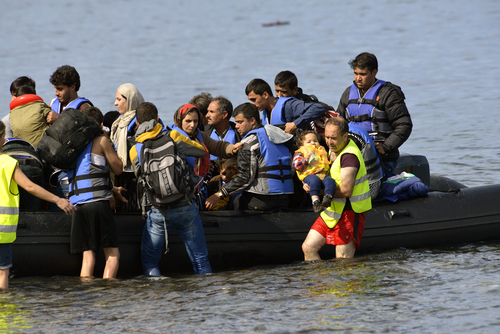Single News
Helping children on the margins of existence
KARLSRUHE (NNA) – “Wars, conflict and persecution have forced more people than at any other time since records began to flee their homes and seek refuge and safety elsewhere.” So says the UN refugee agency, the UNHCR, in its latest annual Global Trends report published earlier this year.
At the end of 2014 the number had risen to a staggering 59.5 million compared to 51.2 million a year earlier and 37.5 million a decade ago, the agency says, and given the upheavals of 2015 this rapidly rising trend is unlikely to have abated.
To give these unimaginable figures some meaning, the UNHCR also puts it a different way: “Globally, one in every 122 humans is now either a refugee, internally displaced, or seeking asylum. If this were the population of a country, it would be the world's 24th biggest.”
Most alarmingly, however, the refugee agency says that almost half of the world’s forcibly displaced people are children and many spend their entire childhood far from home: “Whether they are refugees, internally displaced, asylum-seekers or stateless, children are at a greater risk of abuse, neglect, violence, exploitation, trafficking or forced military recruitment. They may also have witnessed or experienced violent acts and/or been separated from their families.”
Emergency education in the “forecourt of hell”
It is with these most vulnerable and traumatised of refugees that the international organisation Friends of Waldorf organisation works through its emergency education teams. Although they are ready to work in all parts of the world where man-made or natural disasters occur, the large numbers of refugees from the conflicts in the Middle East, Syria in particular, and from north and sub-Saharan Africa means that their recent work has been concentrated in Europe and the Middle East: in refugee camps in northern Iraq, on the Greek island of Lesbos, and in Slovenia.
“Forecourt of hell” is how team leader Bernd Ruf describes the scene on Lesbos where many of the refugees seeking a safe haven in Europe literally wash up on the shore in rubber dinghies.
“Every boat that reaches the coast has a tragedy to report,” Ruf writes. “A five-year-old girl cries frantically about the death of her mother who drowned during the crossing. The mother of a five-month-old infant grieves for the loss of his twin.”
Or there is Oous (15), who fled with his uncle from Somalia after his family was murdered by a milita and he too had to fear for his life. His uncle died during the crossing of the Mediterranean. “Oous tells how his uncle’s body was finally thrown overboard,” Ruf recounts. Like Oous, many children are on their own, unaccompanied minors.
There is desperation in the separate camp for unaccompanied children which, writes Ruf, is more like an internment or prison camp. There is an atmosphere of despair, aggression and fear, suicide attempts are a common occurrence. Shortly after the emergency education team arrives, a boy tries to cut his throat on the barbed wire surrounding the camp. He is not the only one.
The children and young people in Moria camp urgently require pedagogical attention and stabilising structures to turn what feels like an internment camp into a “child-friendly space”, Ruf adds. That is what the team is there to do. Methods based on Waldorf education are intended to reduce trauma-related stress reactions. Movement exercises help to restore inner and outer equilibrium and strengthen trust in themselves and others. Painting and drawing offer nonverbal opportunities to express and come to terms with what the children have experienced.
Calming effect
The emergency education team of the Friends of Waldorf Education encountered conditions which were just as chaotic when they subsequently went in early November to the Sentilj refugee camp in Slovenia on the Austrian border. Seven to ten thousand refugees passed daily through the border crossing point into Austria.
The cramped conditions – there are about 1000 people to each large tent – lead to tension between different ethnic groups and mass fights will break out for minor reasons which are then put down by the huge police deployment. “In the middle of such a commotion a mother hands me her infant across the barrier in despair because she is anxious that he might be crushed. What is left at the end are many injured and fearful people,” Bernd Ruf recounts.
Emotionally stabilising and supporting children in such situation is the main task of the Waldorf team. Each day, the teachers and therapists offer psychosocial help.
An opening circle starts with a song followed by rhythmical clapping and stamping exercises. Then the circle starts to form a spiral which moves inward and outward. After the big circle the children go to their various workshops where they paint, sing and engage in group work base on experiential education. “A closing circle with rhythmical exercises and a closing song concludes the work and we say goodbye to the children for the day,” writes Ruf.
A member of the Slovenian civil defence forces, who has been observing the emergency education work with the children, comments to the team in surprise how quickly the children noticeably begin to relax and how the peaceful and calming atmosphere also reduces the tension among the adults: “The work with the children has a deescalating effect. We could calm the situation with emergency education and not need so many police!” she says.
Long-term commitment
But the emergency education work of the Friends also has a longer term perspective. Seven times an emergency education team has travelled to northern Iraq since it went there for the first time in 2013, most recently in mid-November.
Alongside the emergency education work to help the children in the refugee camp overcome their trauma through experiential, movement and music education, clay modelling and form drawing, their work has also focused on training teams in the region. The aim is to strengthen the skills of local teachers and helpers and establish long-term emergency education structures which will be able to continue the work when there are no international experts present.
In Workshops and daily conversations, the work so far was reviewed and future work set out.
But deeper questions such as “Who am I?” and “What is my goal?” were also dealt with in intensive coaching and psychological counselling. Despite the continuing difficult situation the motivation to continue with the work is high among most of the local team members, the Friends say.
The reason for this can also be seen in the visibly positive changes which can be observed in many children. They flourish in the workshops, become calmer and begin to show trust in other people again.
Take Said, aged eleven. At the last deployment of the team in September he flinched at every touch as if he was afraid that someone was going to hit him. He was noticeable by his aggressive and problematical behaviour and it was difficult to persuade him to participate in a way that was acceptable for everyone.
“This time Said came to us of his own accord. He sought contact with us and wanted a cuddle. He was noticeably less tense. And he laughed a lot,” team member Robert Murata says.
For as long as people are forced to flee conflict and persecution, often under terrible life-threatening and traumatic circumstances, to seek safety elsewhere, the work with refugee children of the emergency education teams of the Friends of Waldorf Education will be more necessary than ever.
END/nna/cva
Donations:
Online: www.freunde-waldorf.de/en/donate-help/online-donation.html
Switzerland
Freie Gemeinschaftsbank, IBAN: CH97 0839 2000 0000 0115 5, SWIFT / BIC: FRGGCHB1
Netherlands
Triodos Bank NV, Zeist, IBAN: NL TRIO 0212 2688 72, SWIFT / BIC: FRGGCHB1
USA
RSF Social Finance, 1002A O´Reilly Ave., San Francisco, CA 94129; online donation or send a cheque.
Item: 151222-01EN Date: 22 December 2015
Copyright 2015 News Network Anthroposophy Limited. All rights reserved.

